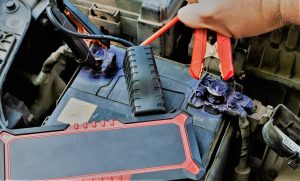A jump starter is a fantastic piece of equipment for reviving dead car batteries. However, improper use can result in harm. That’s why it’s crucial to know how your jump starter’s safety features function in an emergency so you don’t endanger yourself, others in it, or your car. In this piece, I’ll explain everything you need to know about the safeguards provided by jump starters.
Types of Jump Starter Safety Features

1. Reverse Polarity Protection
Reverse polarity protection is one of the best safety features in jump starters. With the help of this feature, you can easily detect a mismatch of connecting wires in the wrong terminals. Moreover, it also measures the voltage on the battery terminals. The battery will not receive electricity from the jump-starting if the voltage is incorrect. This means that the jump starter will not send electricity if the positive cable is attached to the negative terminal. Or the negative cable is connected to the positive terminal. Some jump-starts contain to let you know that the wires are plugged in incorrectly.
Detecting and avoiding damage from reverse polarity is an essential safety element of any jump starter. Jump starting can be dangerous, so a jump starter with a voltage check is vital before connecting the cables to the battery.
2. Overcharge Protection
Another best safety feature is overcharge protection. When a battery is overcharged, it produces excess heat and may release liquid, which poses safety risks. So it protects the battery from being overcharged.
Some jump starter has a built-in circuit that monitors the battery’s charge level and automatically stops charging when it reaches its maximum capacity. Basically, this circuit contains sensors that detect the battery’s voltage and temperature. And these sensors automatically interrupt the charging process to prevent damage. It also stops the charging current or reduces the charging voltage until the battery cools down.
So whenever you purchase a jump starter, look for this feature.
3. Spark-Proof Technology
Spark-proof technology is another safety element found in jump starts. With help of this technology, it prevents sparks in the jump starter. You know sparks can be dangerous in a variety of ways. This spark can cause fires, exploding batteries, and electric shock. This hazardous situation happens because of the excessive energy that needs to jump-start a car. Spark-proof jump starts have multiple safeguards in place to prevent accidental sparking. Examples include:
- Surge protection
This function restricts the amount of current that may flow through the jump starter to prevent surges that could cause flames.
- Anti-spark technology
There is special wiring in some jump starters that stops flames from flying when the jump start is attached or removed from the car’s battery.
4. Automatic Shut-Off
Most modern jump starts have an automatic shutoff function for added security. It monitors the charging process and battery life and turns the power off when appropriate. This feature comes with the following:
- Battery fully charged
The jump-starting will automatically shut off when the battery is full to avoid overcharging.
- Short circuit
It is possible for a jump starter to cut off immediately if it detects a short circuit in the vehicle’s electrical system to protect both your jump starter and the car from damage.
- Inactivity
The jump starter may cut off automatically to preserve power if not used for a while.
Jump starts’ automated shut-off feature protects batteries and ensures safety. So it is a vital feature that you should have in your jump starter.
How to Use Jump Starter Safety Features?
1. Follow the Instructions
Misusing a jump starter can be hazardous and cause harm to your car or the jump starter itself because of the high amounts of electrical energy involved. So it is vital to follow the instructions provided with your jump starter to ensure you properly use all its safety features.
If you are unaware of jump starter usage, you can make some mistakes, like connecting the cable to the wrong battery pole. Sometimes you forget to turn off the charger of the jump starter while its charge is complete. All these mistakes can shorten your jump starter life and damage your car.
2. Proper Use
To properly use jamp starter safety features, you must attach the jump starting to the battery. Next, it’s also vital to completely charge the jump starting before using it. Lastly, wear protective apparel like mitts and goggles whenever you use a jump starter.
3. Maintenance
You must keep your jump starter in dry and cold places. Or you can keep it at room temperature. Then you should check the cables regularly to find any damaged parts so that you can replace them immediately. To avoid troubleshooting problems with jump starter safety features, you must check the battery level and connections daily. If you identify any, just call an expert to repair them.
However, Maintain a battery-less jump starter by recharging it after each use, and inspecting its cables and connections regularly. Store it safely, away from moisture and extreme temperatures, and keep it ready to use in case of emergency.
Conclusion
The proper functioning of your jump starter depends on its safety features. Knowing and using these features properly, you can avoid mishaps and jump starter harm. If you want your jump starter to last and work reliably, follow the directions precisely, use it correctly, and keep it in good working order. After reading this article, I hope you understand how to maintain a jump starter.

As a mechanical engineer, it’s easy for David to explain the functionality of the tool. David test most of the tools before writing a review. its help him to learn something new and suggest the best product for you.





